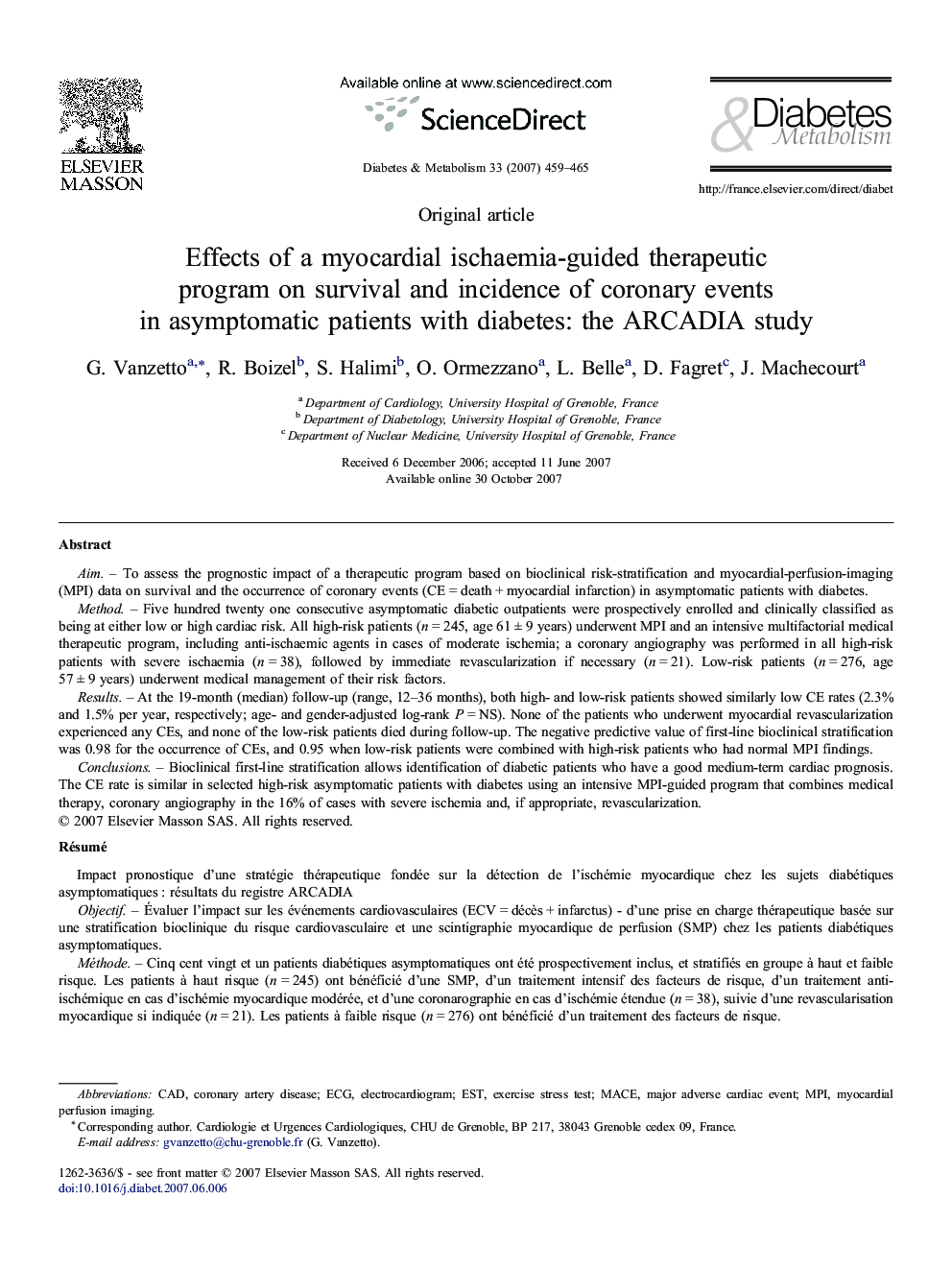| کد مقاله | کد نشریه | سال انتشار | مقاله انگلیسی | نسخه تمام متن |
|---|---|---|---|---|
| 3260677 | 1207634 | 2007 | 7 صفحه PDF | دانلود رایگان |

AimTo assess the prognostic impact of a therapeutic program based on bioclinical risk-stratification and myocardial-perfusion-imaging (MPI) data on survival and the occurrence of coronary events (CE = death + myocardial infarction) in asymptomatic patients with diabetes.MethodFive hundred twenty one consecutive asymptomatic diabetic outpatients were prospectively enrolled and clinically classified as being at either low or high cardiac risk. All high-risk patients (n = 245, age 61 ± 9 years) underwent MPI and an intensive multifactorial medical therapeutic program, including anti-ischaemic agents in cases of moderate ischemia; a coronary angiography was performed in all high-risk patients with severe ischaemia (n = 38), followed by immediate revascularization if necessary (n = 21). Low-risk patients (n = 276, age 57 ± 9 years) underwent medical management of their risk factors.ResultsAt the 19-month (median) follow-up (range, 12–36 months), both high- and low-risk patients showed similarly low CE rates (2.3% and 1.5% per year, respectively; age- and gender-adjusted log-rank P = NS). None of the patients who underwent myocardial revascularization experienced any CEs, and none of the low-risk patients died during follow-up. The negative predictive value of first-line bioclinical stratification was 0.98 for the occurrence of CEs, and 0.95 when low-risk patients were combined with high-risk patients who had normal MPI findings.ConclusionsBioclinical first-line stratification allows identification of diabetic patients who have a good medium-term cardiac prognosis. The CE rate is similar in selected high-risk asymptomatic patients with diabetes using an intensive MPI-guided program that combines medical therapy, coronary angiography in the 16% of cases with severe ischemia and, if appropriate, revascularization.
RésuméObjectifÉvaluer l'impact sur les événements cardiovasculaires (ECV = décès + infarctus) - d'une prise en charge thérapeutique basée sur une stratification bioclinique du risque cardiovasculaire et une scintigraphie myocardique de perfusion (SMP) chez les patients diabétiques asymptomatiques.MéthodeCinq cent vingt et un patients diabétiques asymptomatiques ont été prospectivement inclus, et stratifiés en groupe à haut et faible risque. Les patients à haut risque (n = 245) ont bénéficié d'une SMP, d'un traitement intensif des facteurs de risque, d'un traitement anti-ischémique en cas d'ischémie myocardique modérée, et d'une coronarographie en cas d'ischémie étendue (n = 38), suivie d'une revascularisation myocardique si indiquée (n = 21). Les patients à faible risque (n = 276) ont bénéficié d'un traitement des facteurs de risque.RésultatsÀ 19 mois de suivi [12–36], le taux d'ECV était identique dans les groupes à haut et faible risque (2,3 et 1,5 %/an respectivement, Logrank P = NS). Aucun patient revascularisé n'a présenté d'ECV, et aucun patient à faible risque n'est décédé de cause cardiaque. La valeur prédictive négative de la stratification bioclinique pour la survenue d'un ECV était de 98 % ; elle était de 95 % en combinant patients à faible risque et patients à haut risque avec SMP normale.ConclusionUne stratification bioclinique simple permet d'identifier une population diabétique avec un bon pronostic cardiovasculaire à moyen terme. Le pronostic des patients à haut risque bénéficiant d'une prise en charge basée sur la SMP — traitement médical et stratégie invasive avec revascularisation le cas échéant — est identique à celui des patients à faible risque cardiovasculaire.
Journal: Diabetes & Metabolism - Volume 33, Issue 6, December 2007, Pages 459–465